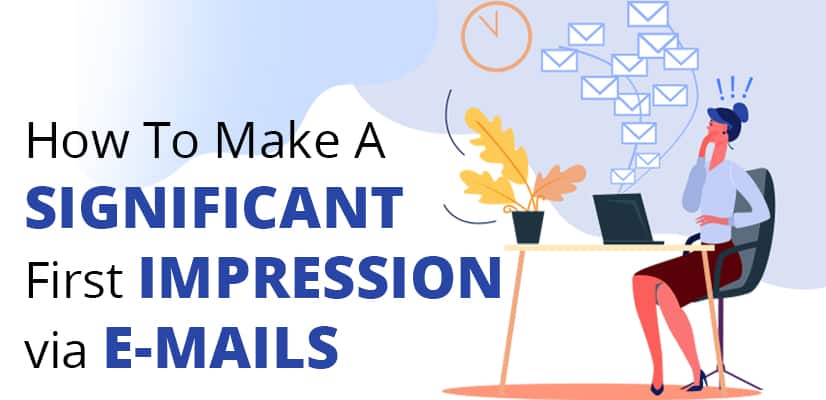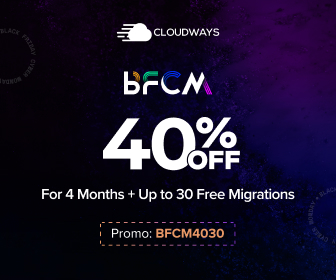A lot of time business talking to clients through call service. For most business owners, phone conversations are daily practices. However, nowadays many conversations are had over the internet. So there is a chance that good conversations can take place over email.
Even so, only 57.7% of brands send welcome emails to new subscribers that means many fail.
Source: socialmediatoday.com
But unlike a phone conversation, email conversations make it harder to make good first impressions. If you’re using email marketing services to communicate with any of your first-time customers, it’s really important to be mindful of a few choice methods by which it will make your business look more professional.
What's a Welcome Email?
A welcome email is one of those things that every marketer should do. Welcome email is mostly the first formal mail conversation which means your first impression on your clients and customers, It’s not just for brand recognition and customer retention, but also to help build credibility and trust in your company. According to Hubspot, “Welcome emails increase engagement rates by up to 20 percent and conversion rates by as much as 50 percent.” (source)
So what exactly does this mean? Well, if you're sending an email to someone who has never heard about your product or service before, then chances are they won't open it. But if you send them a welcome email, you'll give them a reason to want to read it. And when they open it, they'll feel like they've already been treated well.
Why You Should Send a Welcome Email?
The biggest advantage of sending a welcome email is that it helps you get started on building relationships with your future customers because that will be the first-ever conversation with them. When people sign up for your newsletter or subscribe to your blog, they become part of your community. They start receiving updates from you, so they know they can expect a steady stream of helpful information and content.
If you don't offer anything useful to them, they might unsubscribe. But if you have something valuable to share, they'll stick around. In fact, according to MailChimp, "Customers who receive a welcome email after subscribing to a list are 30% more likely to stay subscribed."
Another benefit of sending a welcome email to new subscribers is that it makes you look more trustworthy. People often assume that businesses don't care about them because they haven't done business with them before. By showing that you're willing to go out of your way to welcome them, you show that you're invested in their success.
Things You'll Wanna Include in a Welcome Email:
When crafting an email to a customer, be sure to include a strong subject line. Grab their attention with a clear subject line that reflects your message's goal. Be careful not to come across as spammy.
Share links to other products or services you provide and let them know about any blogs or other useful information you have. Let them know how to modify their settings to avoid future messages.
Editor's Note: You're probably wondering how you can turn your passion into a profitable business. If you've ever tried to write something yourself, you know there's nothing worse than trying to figure out what to say next. That's why we started SmartCopy — an AI-powered tool that helps writers create great copy every time.
Here's how it works:
We analyze millions of words written by our team of experts and then teach them how to write great content for your brand. So when you need fresh, quality content, just ask us to write anything from blog posts to sales letters to product descriptions.
And if you'd prefer to let us handle all the heavy lifting, we'll even do that too! Try it free today.
Common Email Mistakes to Avoid
1) Weak or no Subject Line
Sending an introduction email without a strong subject line is bad for the email open rate. But you know what's even worse - sending an introduction email without having a subject line. You should pay attention to your subject lines. Why? More than half of email recipients read the subject line before they open the email.
2) Not optimizing for mobile devices
According to Email Monday’s research, 81% of people access email from a smartphone. Therefore, failing to optimize or properly format your email for mobile devices is a costly introduction email error.
3) Having an Unclear CTA
No matter who your email recipient is, whether a cold lead, a new subscriber, or a business contact, you want them to take action. Knowing that you need a "Call to Action" isn't enough. A CTA in your introduction email is also critical for conversion. A CTA could be a request to schedule a meeting, reply to your email, etc. A business introduction email is the same.
4) Poor Proofreading and Editing
Misspelled words are a common email mistake, according to Grammarly. In addition, they make you appear unprofessional. Before submitting your email, make sure you reread it at least twice.
5) Not including an opening greeting
It seems rude to send your first email in a conversation without a basic greeting. A greeting can be formal or informal, but it sets the proper tone.
6) Being too informal too soon
Special care should be taken when initiating a conversation with a business contact or someone you don’t know. Being too informal can make a bad impression on the recipient and undermine your credibility.
7) Having too much information in your email signature
That’s a sign of poor email etiquette. Make sure you’re not making these terrible email signature mistakes
Some Great Examples of Welcome Emails to Inspire Your Own Strategy
It's always nice when you get an email that says something like “Hey! I just wanted to let you know that we received your email and were wondering if there was anything else we could help you with?” But what happens if you receive an email that seems to come straight out of a marketing textbook? If you're expecting a sales pitch, you'll likely feel offended and irritated. You may even delete the message altogether. However, if you're expecting a friendly reminder about a service you signed up for, you might actually appreciate the email.
1) Virgin American
A welcome email is a great way to introduce yourself, your company, and what makes you different. It's a perfect medium for introducing people to the characteristics (and quirks!) that make your brand unique! For Virgin America, that meant putting the "I love YOU" hand symbol front and centre. This small gesture signals that the folks at Virgin American care about their customers. Their playful accompanying copy, "WELCOME ABROAD", and casual call-to action, "GRAB A SEAT", also help to position them as a hip, fun loving brand right off the bat!
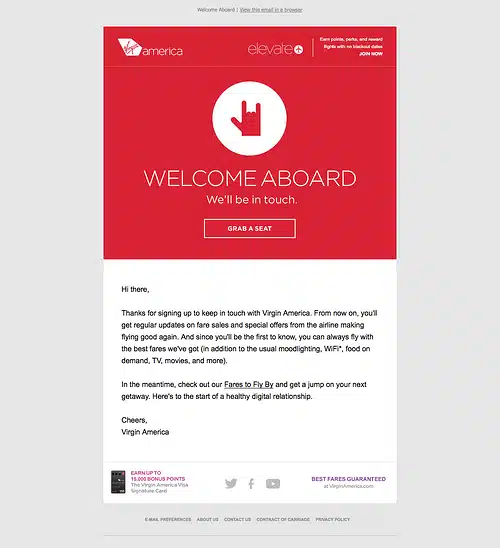
2. Food52
Type of welcome: Get Started
We brought snacks. Sometimes the tiniiest of elements in a welcome e-mail can speak volumes about a company. And when it comes the Food52's welcome email its preview text at the top, “We brought snacks,” definitely accomplishes this.
Food52’s welcome email also does a great job of building trust by showing a picture of the founders. As soon as you click through, you see a photo and message from the company’s founders.
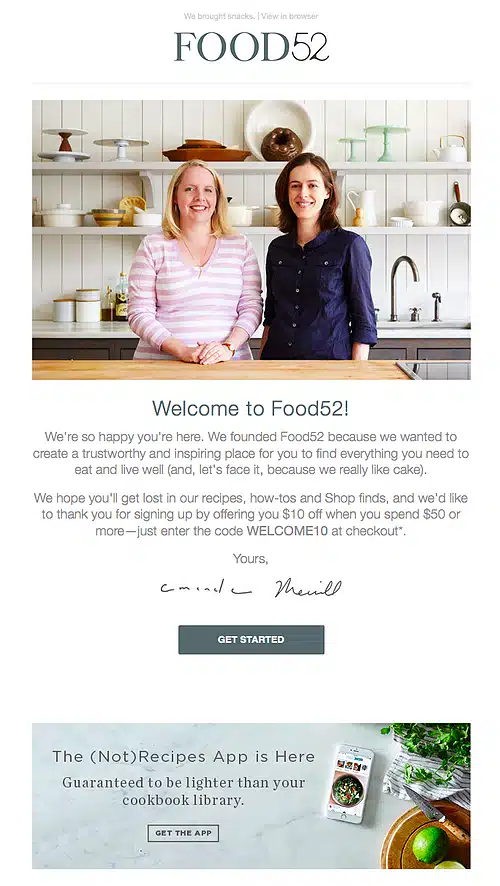
3. IKEA
Type- Offer
IKEA offers an offer instead of a sales pitch. You get to try out all kinds of furniture you may never have considered before, and then you get free shipping if you buy a certain amount. If you're interested, you'll get a link to their website where you can browse through their products. They also have a lot of videos about their furniture, and they even have a blog.
If you aren't interested in any of that other stuff, just sign up here. You'll get an email with your username and password. Then, when you're ready to shop, click through to the site and log in. There's a big "Login" button at the top of every page.
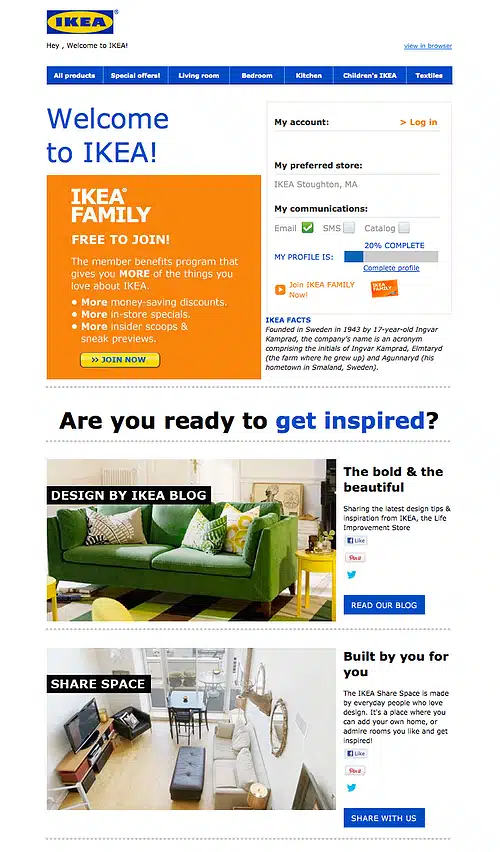
TIps on making a Memorable first impression
1) Be personal
If you’ve collected all the details about your subscriber in the signup process use them in your email. Try to personalize your emails with first names, gender, and interests.
2) Make an expectation
Let your subscribers know what sort of products you’ll be sending and how often you’ll email them. This is particularly good because not only will you let them know how frequently you will email them and exactly what they have signed up for. Expectations should be clearly set.
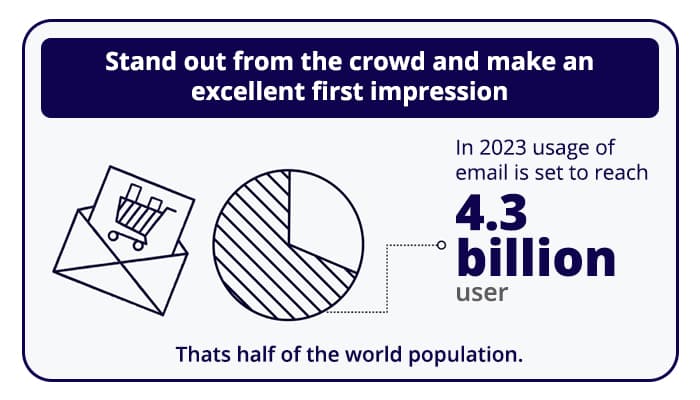
3) Quick reply
When you receive an email is not much different from receiving a voicemail. The customer who left it for you expects a reply within a short amount of time which could be in 2 days. Try to avoid reading emails and saying that you’ll “get to them later”. The customer who has sent you the email is waiting for you to respond. The longer you take to do so, the worse the impression you give them.
4) Have a professional email address
The very first thing that your first-time customer will see when they receive your email is your email address. By now, you should have an address that incorporates your business domain name in it. Using a Gmail or Hotmail account may not always look all that professional to customers.
5) Reward your new subscribers
Using an incentive is an effective plan to help get people to subscribe to your email. An unexpected reward for signing up creates a good image of the brand in customer thought.
6) Generate the "A-ha"
A welcome email is a critical part of any marketing campaign. Not only does it help establish trust with the recipient, but it also allows you to start establishing relationships with them. If you can get someone to sign up for your newsletter or blog subscription within 7 days, they will be much more likely to see your core message and come back to your site again.
The goal of every website is to convert visitors into customers. But not all websites accomplish this goal. Some websites are designed to sell products or services while others are designed to provide information or entertainment. If you're looking for ways to increase conversions, start by identifying what your core value is. Next, figure out the steps required to achieve this value. Finally, create an onboarding flow that guides users through those steps.





